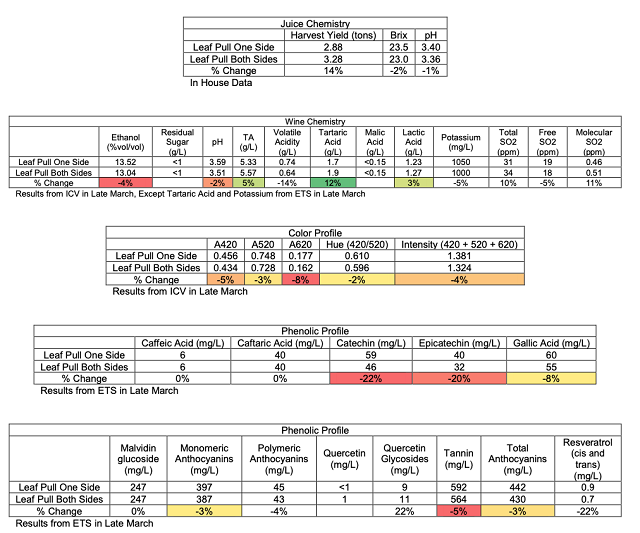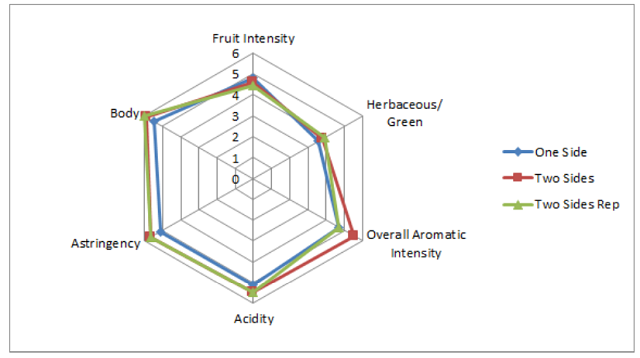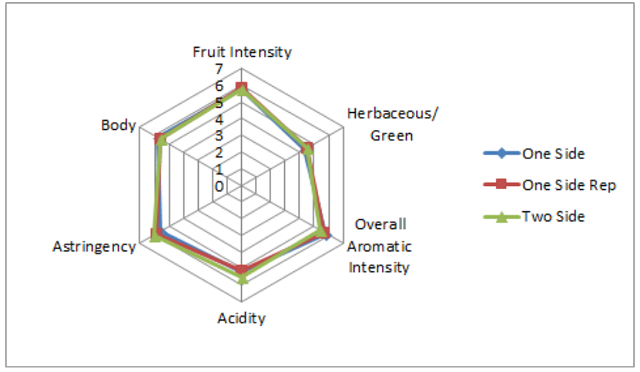Leaf Pulling on One vs Two Sides of Petit Verdot Vines (2017)
Damien Blanchon
Afton Mountain Vineyards
Summary
This study examines the impact of leaf pulling on one vs both sides of the vine in Petit Verdot. Petit Verdot vines (clone 400, planted 2012, 9x4 spacing, ESVC/CW index of 2.4) from the same block were split so that all vines received leaf pulling on the east side at flowering, and one portion of the vineyard received leaf pulling on the west side as well at veraison. Grapes were harvested on the same date, and all winemaking practices were identical between treatments. Must was inoculated with D80, Enzyme CX was added, punched down twice per day until fermentation was complete, and then switched to one punchdown per day during extended maceration (25 days maceration time, total). Juice chemistry was similar between treatments, although leaf pulling on one side resulted in higher alcohol content and lower acidity. Color and anthocyanin were not much impacted by treatments. Seed tannin indices (catechin, epicatechin, and gallic acid) may have been slightly lowered with leaf pulling on both sides. Tannin may have slightly decreased by this treatment, as well. The sensory results suggest that the two wines were significantly different. No strong trends could be seen for the descriptors used in this study, although Acidity seemed to be lower in the one sided leaf pulling wine. No major preference trends could be seen between treatments. This study should continue to be performed over multiple years, in different regions, as well as on different grape varieties.
Introduction
Leaf pulling in the fruiting zone reduces disease pressure, helps fruit to dry, and can improve chemical composition of the fruit. However, removing too many leaves can result in too high of acid reduction and sunburn. Generally, leaf pulling is performed at or after fruit set, which increases the fruit’s resistance to sunburn (Wolf 2001). However, leaf removal is often performed after berry set. Recently, great interest has arisen in investigating the impact of the timing of leaf removal on fruit yield, micro-climate, and quality.
Because basal leaves at bloom are the primary source of carbohydrates for inflorescences at this stage (Coombe 1962), pre-bloom leaf removal reduces set, potentially reduces berry size, and thus reduces cluster weight (Poni et al. 2006; Tardaguila et al. 2010, Gatti et al. 2012, Palliotti et al. 2012, Risco et al. 2014; Bubola et al. 2017). Early leaf removal results in less compact clusters, which helps to reduce Botrytis incidence as well as reduces crop yield, which may be of benefit for high yield vineyards or with compact clusters (Palliotti et al. 2011; Bubola et al. 2017). It also tends to reduce berry size and enhance many chemical ripeness parameters, such as increasing Brix, tannin, and athocyanin (Diago et al. 2012, Palliotti et al. 2012, Lee and Skinkis 2013, Cook et al. 2015, Silvestroni et al. 2016; Smith and Centinari 2017; Bubola et al. 2017). Pyrazine is often lowered due to leaf pulling, with early leaf removal often having more impact than later leaf removal (Scheiner et al. 2010). Indeed, early leaf pulling can sometimes impact these ripeness parameters in grapes to a greater extent than cluster thinning, particular in high vigor varieties where cluster thinning does not alter canopy microclimate much (Bubola et al. 2017). The purpose of the present study is to investigate leaf removal on one vs both sides of the vine in Petit Verdot. The east side of the vines received leaf pulling at flowering, and then on one part of the block the west side of the vine had leaves pulled at veraison.
Results and Discussion
Juice chemistry was similar between treatments, although leaf pulling on one side resulted in higher alcohol content and lower acidity. Color and anthocyanin were not much impacted by treatments. Seed tannin indices (catechin, epicatechin, and gallic acid) may have been slightly lowered with leaf pulling on both sides. Tannin may have slightly decreased by this treatment, as well. These results suggest that increased sun and temperature exposure may have had a negative impact on tannin development and overall ripening.

|
|
For the triangle test on April 18, of 10 people who answered, 6 people chose the correct wine (60%), suggesting that the wines were not statistically significantly different. They would be significantly different at this level with a p<0.10. Of people who correctly identified the wines, 4 preferred the leaf pull on both sides and 2 preferred one sided leaf pulling. There were no strong trends for the descriptors used in this study. There was a slight tendency for the leaf pulling on both sides to have increased scores for all descriptors used, especially with Overall Aromatic Intensity, Astringency, and Body.

For the triangle test on May 2, of 25 people who answered, 14 people chose the correct wine (56%), showing a statistically significant difference between wines (p<0.05). These wines were voted to have an average degree difference of 4.2 (out of 10), suggesting that the wines were moderately different. In general, people who answered correctly preferred the one sided-leaf pulling over the two sided leaf pulling. 9 judges preferred the one sided leaf pull, 4 judges preferred the two sided leaf pull, and 1 judge had no preference. For the descriptive analysis, there were no strong trends for the descriptors used in this study. There was a slight tendency for one sided Leaf Pulling to have higher Overall Aromatic Intensity and lower Acidity.

These results suggest that the two wines were significantly different. No strong trends could be seen for the descriptors used in this study, although Acidity seemed to be lower in the one sided leaf pulling wine. No major preference trends could be seen between treatments. This study should continue to be performed over multiple years, in different regions, as well as on different grape varieties.
Methods
A 1 acre block of Petit Verdot (clone 400, planted in 2012, half on 101-14 and half on Riparia rootstocks, 9x4 spacing) was split so that some of the block only had the leaves on the east side of the vine pulled, whereas the other half of the block had leaves on both sides of the vine pulled. Leaf pulling on the east side was done after flowering, and leaf pulling on the west side was done at veraison (only for the treatment with both sides pulled). All other vineyard practices were equal between vines. Vegetation height was 59 inches, thickness of 12 inches, 2.5 feet trunk height. This corresponds to an H/E index of 1.2, and ESVC/CW Index of 2.4.
Grapes were harvested on September 24, 2017 (4.93 tons/acre over 1.25 acres, totalling 36hL). Grapes were stored cold overnight (10 hours), and on September 25 grapes were sorted and destemmed into 1 ton T bins. At this time, 30ppm sulfur dioxide and 60mL/ton Enzyme CX were added to each T bin. T bins were inoculated with D80 at 15g/hL rehydrated with GoFerm at 30g/hL at this time as well. Fermentations received 2 pumpovers per day for 3 days then were punched down twice per day until fermentation was done. After fermentation was complete, caps were punched down once per day until pressed off. T bins were pressed off into tank on October 20, for 25 days of total maceration. Wine was racked into barrel on November 2, and after the end of malolactic fermentation 50ppm sulfur dioxide was added. On March 26, sulfur was adjusted with 22ppm sulfur dioxide, and then samples were taken for the research exchange. Samples came from 2016 Nadolie Virginia oak barrels, Medium plus toast.
These wines were tasted on April 18 and May 2. For the triangle test, descriptive analysis, and preference analysis for the April 18 tasting, anybody who did not answer the form were removed from consideration for both triangle, degree of difference, and preference. Additionally, anybody who answered the triangle test incorrectly were removed from consideration for degree of difference and preference. Additionally, any data points for preference which did not make sense (such as a person ranking a wine and its replicate at most and least preferred, when they correctly guessed the odd wine) were removed.
In order to balance the data set to perform statistical analysis for descriptive analysis on the April 18 tasting, any judge who had not fully completed the descriptive analysis ratings were removed. In order to then make the number of judges between groups equivalent, one judge from group 3 was transferred to group 2. This resulted in a final data set of 3 groups, each with 3 judges (considered as replications within groups, and groups were considered as assessors). Data was analyzed using Panel Check V1.4.2. Because this is not a truly statistical set-up, any results which are found to be statistically significant (p<0.05) will be denoted as a “strong trend” or a “strong tendency,” as opposed to general trends or tendencies. The statistical significance here will ignore any other significant effects or interactions which may confound the results (such as a statistically significant interaction of Judge x Wine confounding a significant result from Wine alone). The descriptors used in this study were Fruit Intensity, Herbaceous/Green, Overall Aromatic Intensity, Acidity, Astringency, and Body.
The same procedures for data analysis were used on the May 2 tasting. For the descriptive analysis in this tasting, one judge was transferred from group 2 to group 3 so that each group had 7 judges, for a total of 21 judges.
References
Bubola, M., Paolo Sivilotti, P., Janjanin, D., and Poni, S. 2017. Early leaf removal has larger effect than cluster thinning on cv. Teran grape phenolic composition. Am. J. Enol. Vitic. In Press.
Cook, M.G., Zhang, Y., Nelson, C.J., Gambetta, G., Kennedy, J.A., and Kurtural, S.K. 2015. Anthocyanin composition of Merlot is ameliorated by light microclimate and irrigation in Central California. Am J Enol Vitic 66: 266-278.
Coombe, B.G. 1962. The effect of removing leaves, flowers and shoot tips on fruit-set in Vitis vinifera L. J. Hortic. Sci. 37:1-15.
Coombe, B.G. 1962. The effect of removing leaves, flowers and shoot tips on fruit-set in Vitis vinifera L. J Hortic Sci 37:1-15. 423
Diago, M.P., Ayestarán, B., Guadalupe, Z., Poni, S., and Tardáguila, J. 2012. Impact of prebloom and fruit set basal leaf removal on the flavonol and anthocyanin composition of Tempranillo grapes. Am J Enol Vitic 63:367-376.
Gatti, M., Bernizzoni, F., Civardi, S., and Poni, S. 2012. Effects of cluster thinning and preflowering leaf removal on growth and grape composition in cv. Sangiovese. Am J Enol Vitic 63:325-332.
Lee, J. and Skinkis, P.A. 2013. Oregon 'Pinot noir' grape anthocyanin enhancement by early leaf removal. Food Chem 139:893-901.
Palliotti, A., Gardi, T., Berrios, J.G., Civardi, S., and Poni, S. 2012. Early source limitation as a tool for yield control and wine quality improvement in a high-yielding red Vitis vinifera L. cultivar. Sci Hortic 145:10-16.
Palliotti, A., Gatti, M., and Poni, S. 2011. Early leaf removal to improve vineyard efficiency: gas exchange, source-to-sink balance, and reserve storage responses. Am J Enol Vitic 62:219-228.
Poni, S., Casalini, L., Bernizzoni, F., Civardi, S., and Intrieri, C. 2006. Effects of early defoliation on shoot photosynthesis, yield components, and grape composition. Am J. Enol. Vitic. 57: 397-407.
Risco, D., Pèrez, D., Yeves, A., Castel, J.R., and Intrigliolo, D.S. 2014. Early defoliation in a temperate warm and semi-arid Tempranillo vineyard: vine performance and grape composition. Aust J Grape Wine Res 20:111-122.
Scheiner, J.J., Sacks, G.L., Pan, B., Ennahli, S., Tarlton, L., Wise, A., Lerch, S.D., and Vanden Heuvel, J.E. 2010. Impact of severity and timing of basal leaf removal on 3-isobutyl-2-methoxypyrazine concentrations in red winegrapes. Am. J. Enol. Vitic. 61: 358-364.
Silvestroni, O., Lanari, V., Lattanzi, T., Alberto, A., and Sabbatini, P. 2016. Impact of crop control strategies on performance of high-yielding Sangiovese grapevines. Am J Enol Vitic 67:407-418.
Smith, M. and Centinari, M. 2017. Early season grapevine canopy management, Part II: Early leaf removal (ELR). Wine & Grapes U. https://psuwineandgrapes.wordpress.com/2017/06/02/earlyseason-grapevine-canopy-management-part-ii-early-leaf-removal-elr/
Sternad Lemut, M., Sivilotti, P., Butinar, L., Laganis, J., and Vrhovsek, U. 2015. Pre-flowering leaf removal alters grape microbial population and offers good potential for a more sustainable and cost-effective management of a Pinot Noir vineyard. Aust J Grape Wine Res 21:439-450.
Tardáguila, J., de Toda, F.M., Poni, S. and Diago, M.P. 2010. Impact of early leaf removal on yield and fruit and wine composition of Vitis vinifera L. Graciano and Carignan. Am J Enol Vitic 61:372-381.
Wolf, T. 2001. Canopy management tips. Viticulture Notes 16(3). Vineyard and Winery Information Series. http://www.sites.ext.vt.edu/newsletter-archive/viticulture/01mayjune/01mayjune.html
